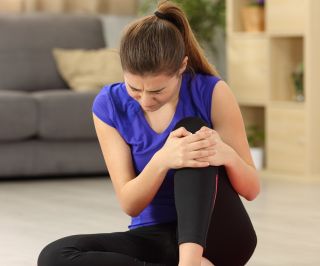Health
The Painful Secret That Gen X Women Need to Talk About
Arthritis often goes untreated, but can be a serious crisis for midlife women.
Updated October 20, 2023 Reviewed by Tyler Woods
Key points
- Osteoarthritis is a degenerative condition that causes severe pain in hand, knee, and hip joints.
- Rates of osteoarthritis are rising among women in their 40s and 50s.
- Degenerative diseases can't be cured, but many treatments are available to manage symptoms.
- Talking about arthritis is the first step toward getting help from friends, family, and employers.

Menopause, once whispered about behind closed doors, finally has its moment in the spotlight.
Actor and talk show host Drew Barrymore had her “first hot flash” on live TV while interviewing her friend and fellow Gen Xer Jennifer Aniston. Goop founder and actor Gwyneth Paltrow shares tips for a healthy perimenopause on Instagram. And Just Like That character Charlotte York Goldenblatt was mortified when a “flash period” interrupted her otherwise symptom-free menopausal transition.
Menopause was given more serious and urgent treatment in a recent New York Times article, which honestly addressed the symptoms that many women experience—sleep problems, mental fogginess, painful sex, depression, and more. Employers in the U.K. and U.S. are stepping up to make workplaces “menopause-friendly,” supplying desk fans to cool down, letting women work at home on those days when their symptoms are overwhelming, and appointing “menopause champions” to support women workers struggling with “the change.”
But there’s another health crisis facing millions of Generation X women that has gone unnoticed: arthritis. The word “arthritis” may conjure images of an octogenarian grandmother, hunched over and struggling to massage Ben-Gay into her disfigured hands or aching knees. Arthritis is certainly a serious concern for older adults, with more than half of Americans ages 65 and older reporting symptoms. But rising numbers of people in their 40s and 50s (mostly women) suffer from arthritis, especially osteoarthritis.
Osteoarthritis (OA) is the most common form of arthritis. It is a degenerative joint disease and is often referred to as “wear and tear” arthritis. Constant pressure on our joints from activities like round-the-clock texting or hitting the pavement on vigorous runs can increase the risk of OA in our hands, hips, and knees. OA can be very painful. As the disease progresses, the cartilage in our joints starts to break down, our bones begin to change, and bone spurs can develop. These changes develop gradually and worsen over time. As symptoms progress from Stage 1 (mild symptoms) to Stage 4 (severe) even simple activities like getting out of a chair or buttoning a shirt can be excruciating.
I know how painful Stage 4 OA is because I have it. The pain is most severe in my thumbs, which doctors refer to as the carpometacarpal (CMC) joint. Everyone’s symptoms are different, but for me, every motion that requires the use of my thumbs hurts. Once-effortless actions like clicking the computer mouse, zipping a coat, combing my hair, tossing my backpack over my shoulder, cutting food, or turning the key to my home now hurt. People can have arthritis in one joint, or several. The half-marathon I ran last month was a breeze for my knees and hips —but pulling on my spandex leggings, tightening my shoelaces, pinching the safety pins that clip my bib to my shirt, and adjusting the volume on my iPhone as I ran along to my favorite ‘80s and ‘90s tunes—were miserable. The worst part? Stage 4 OA sufferers often feel pain even when sitting still and doing nothing.
I’ve yet to see a celebrity or sitcom or flashy Instagram post call attention to severe arthritis, especially among those who are years away from retirement age. But we need to raise awareness and help each other. Experts predict that more and more Americans will suffer “wear and tear” arthritis at younger ages, due to overuse, rising rates of obesity, and other risk factors. So, how do you know if you have arthritis? And how can you manage it?
Get It Checked. Aches and pains are a normal part of aging. But soreness that limits our capacity to work, exercise, climb stairs, groom, drive, or keep house requires medical attention. If your joints cause pain, get an X-ray so a doctor can assess your level of cartilage loss. This information will help you and your physician to develop a plan of action. You can’t stop degenerative disease, but you can manage it.
Know Your Options. There are many options for managing arthritis at each stage. At early stages, you can take an over-the-counter NSAID pain killer or use pain relief gel. A hand or knee brace can help to stabilize your joint. Physical therapy and some exercises can help with strength. Take up a new sport like swimming, to take pressure off your knees. A moist heating pad offers some relief. Some patients say that CBD products and acupuncture are soothing. As the pain intensifies, you might consider corticosteroid injections in your problem joint. The last resort is surgery, which is considered highly effective in minimizing pain and restoring function—although the costs and recovery time may make it an unrealistic option for some -- especially those who live alone or lack a helper.
Learn Some Life Hacks. Aging requires adaptation, no matter what your health woe. Small changes can help to make painful activities more tolerable. Get voice dictation software on your computer and iPhone. A vertical computer mouse can take some pressure off the thumb. Hang your iPhone around your neck with a lanyard, rather than clutching it. Adaptive silverware with large soft handles makes it easier to cut your steak. Ride a bicycle with coaster brakes rather than hand brakes. Find a cute pair of shoes with velcro straps or slip-ons. Use toiletries in pump rather than squeeze bottles. Most importantly, talk to friends who have been there, and ask for their favorite tips.
Ask for Help. Women, and especially women in their 40s and 50s, often are more comfortable giving than getting help. Sandwich-generation women are busy caring for their young adult kids and their aging parents. For many working women, each passing year is filled with more responsibilities, and more demands from colleagues. Asking for help isn’t a sign of weakness, it’s a strategy for maintaining independence in the long-run. Talking to one’s HR (human resources) officer about a workplace accommodation can make physical aspects of work more comfortable, and can help you stay employed for many more years. Asking friends and family for help can give them a sense of purpose and an emotional boost from knowing they’ve done good.
Remember and Celebrate Your Many Strengths. Losing the capacity to do activities that we value (and are valued for) can be distressing. Avid athletes who are sidelined with severe knee arthritis need to let go of an important part of their identity. For writers and academics (like me) whose professional self-worth rests on our capacity to publish, it is disheartening that every key stroke and mouse click are painful. Even worse, for those who work in physical jobs like construction or waitressing, severe arthritis can force an unwanted career change or early retirement. Remember that we all are more than our jobs and our hobbies, and the loss of one activity doesn’t make us lesser people.
Arthritis sufferers and their family are not alone. Organizations like the Arthritis Foundation can provide helpful advice and resources to make a painful condition more manageable. Talking to friends and family honestly about your symptoms can help them to help you. And you might find another friend suffering in silence who can be your ally, supporter, and source of helpful hints to live life to its fullest.




